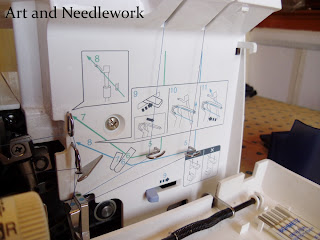I am no way familiar with the 1001 different machine brands and models and haven't a clue what does what, but I do love learning about the "workhorses" (our sewing machines), and sewing equipment people use. Earlier, I talked about how
I store and organize my fabric. For today's post I will be telling you all about the two machines that help me do the stitching.
Side note: Be thankful that I didn't give my post the title: Rise of the Machines! I was this close to doing it but opted for the other because I'm not a big Terminator fan. :)
So I first bring you my Kenmore 385-1764180.
This machine doesn't have much "bling" with computers and such, but he does have twenty-four different built-in stitches; I only use about two of them. :) So from the sounds of it, I don't think a computer would help me out much, I am a straight/zig zag stitch type of sewer.
This machine has many great features (but then again, I do not have a comparison!), such as this hidden storage case:
But it does have its hidden terrors. Such as the flimsy, plastic bobbin case cover.
Looks so unassuming, doesn't it? Oh, little do you know the havoc it has produced when sliding a piece of fabric over it. Because it slides so easily, the cover pops out every now and then and causes my fabric to be pulled into the bobbin case. Maybe I should tape it down or something so I won't be driven insane. . . I need to keep reminding myself of that nifty storage box to restrain myself from putting an ax to the machine. :)
Aside from all that, I do like my Kenmore, maybe it is because it is so basic (less things to break, right?), or maybe it is because it belonged to my mother. It is roughly eighteen years old already and I have never had a malfunction. Whatever the reason for my liking, my Kenmore will be doing much more for years to come.
Now for the new kid on the block. My serger.
It is a Brother 3034D serger and I bought him in the Fall of 2008. It was one of the most expensive purchases I made ($280 from
this source), but it has become something that enhances my sewing; it makes me proud of what I create.
Brother 3034D is a 4-thread serger (makes serging stitches that uses 4 threads instead of the typical 3), with differential feed (a special feed dog that helps stretch or ease the fabric--your choice--when it is moving).
 |
| {thread tension dials} |
 |
{differential feed dial}
|
 |
| {thread guides inside} |
|
|
Tip on Saving Money with Serger Thread:
If you take a look at a garment that has been serged you will notice the extensive amount of loops and stitches that are created with a serger. That calls for a lot of thread! To help with thread costs, I set up my serger with a strange array of spools. Take my last project for instance:
You will notice that I was using a 3-thread overlock stitch and chose to use two large cones--in two different shades of blue--and one small purple spool.
I have only a few large thread cones for my serger: some black, white, ivory, and three different blues. And that's it. Most of the time I just use the cones, but when my project is of a radically different color (such as pink), I will take a small spool of thread that corresponds with the fabric, and use that for the upper or lower loopers or both. And I will use a cone in black or white for the needles.
The finished project will then have serging stitches that match the fabric and I achieved this without buying extra thread. For how many projects do I have that require large cones of hot pink, right?
What about you? Do you love your sewing machine or serger? What do you like or hate about it? Have you given it a name? What machine is on your wish list?
Labels: my sewing room, sewing machines


